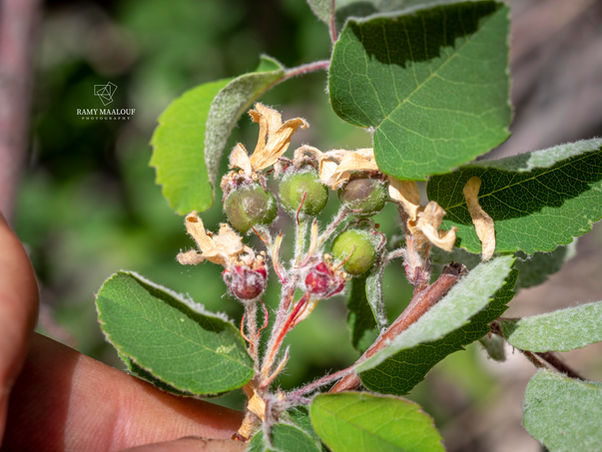Family |
Rosaceae
Amelanchier parviflora
Medik.
Amelanchier parviflora Boiss.
(Boissier, Diagnoses Plantarum Orientalium 3: 9; 1843 – see also Flora of Turkey 4: 398 – 399; 1972)
Life-form & habit : Deciduous, many-stemmed shrub 0.8 – 2 m high; young twigs slender and persistently white-villous, giving the whole plant a silvery cast.
Leaves : Obovate to orbicular, (10) 15 – 20 × 6 – 15 mm; apex obtuse or short-mucronulate, base cuneate; margins entire in the typical variety (var. parviflora), shallow-dentate in var. dentata. Upper surface green and glabrous, underside densely white-tomentose.
Inflorescence : Short, tomentose racemes bearing 4 – 10 flowers; floral pedicels 4 – 8 mm.
Flowers : 10 – 15 mm across; petals 5 – 8 mm, oblong-spatulate, villous outside; calyx teeth triangular-lanceolate, no longer than the tube.
Fruit : Sub-globose pomes 7 – 10 mm, ripening deep purplish-black and sweet; much relished by birds.
Flowering period : March – May at low elevations, April – June in the mountains.
Habitat & elevation : Rocky limestone slopes, forest edges and open maquis from ≈ 600 m to 1 800 m (occasionally lower). Prefers calcareous, well-drained soils in full sun or light shade.
Native range : Eastern Mediterranean endemic. Main range in south-western Turkey (Lycia, Pisidia, Taurus Mts.); subsp. chelmea restricted to the East-Aegean Greek islands. In the Levant it persists as scattered relic stands on Mount Lebanon (Jabal Sannine, Barouk cedar belt) and Mount Hermon, with no confirmed occurrences elsewhere.












